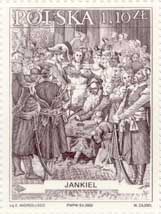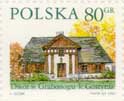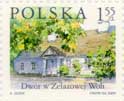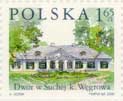| |
|
On June 23rd, 2000, the Polish Post will introduce into the trade two stamps from the issue "Ethos of Work - K. Marcinkowski, E. Balaguer". The said stamps shall represent the following:
Value PLN 0.70 - portrait of Karol Marcinkowski, placed against a 19th century industrial landscape, according to the wood engraving by Tomasz Bewick. The person of the Wielkopolska inhabitant is not known as other eminent personalities of the 19th century are. He was born in Poznań on June 23rd, 1800. He completed his medical studies in Berlin. He started the medical practice in his home city, where he became famous for his engagement and helpfulness, curing poor patients free of charge. He participated in the November Uprising. He emigrated after its defeat. He was active in the Association of the Scientific Assistance in Paris, together with Adam Czartoryski, Adam Mickiewicz, and Julian Ursyn Niemcewicz.
After coming back to Poland, he started to cure especially poor people. He did not give up his medical practice, but he also started to implement his social plans. He thought that the Poles could survive the years of the partitions only thanks to an economic development, modernization of the social structure, and cultural activities.
He summarized his programme in short: "Education and work - these are the means to shape the necessary road". He attracted devoted co-employees coming from the noblemen's families and priests to follow his ideas.
In 1837, he founded an association similar to the Parisian Scientific Assistance Association in Poznań, which granted scholarships to young people attending schools. It was the first scholarship granting institution in Poland.. Marcinkowski considered education to be one of the main bases of a national and economic existence. He realized that only such a type of institutions ensure educated people for the society.
In 1838, he founded a joint-stock company to construct "Bazar", which was opened in 1841. The building, the second biggest one in Poznań, was a modern hotel and it also constituted a center of the Polish economic and social life.
Less than one year before his death, Marcinkowski undertook another initiative. In 1845, he founded an Association for Supporting the Poor in Poznań. The Association's tasks included granting a support to people incapable of work: disabled, old, fight against unemployment, founding schools - orphanages. Karol Marcinkowski died on November 7th, 1846, in D±brówka Ludomska.
Value PLN 0.80 - portrait of Josemaria Eseriva de Balaguera against a sculpture by Andrea Pisano coming from Campanila in Florence.
Josemaria Escriva de Balaguer was born in Barbastro in Spain on January 9th, 1902. He received the holy orders on March 28th, 1925, in Saragossa. Two years later, he was moved to Madrid, where he developed his work in all milleus. He took a special care for the poor and homeless from the social margin districts and those terminally ill in hospitals. In 1928, he founded Opus Dei - a Catholic laic institute. At first, it functioned outside the structures of the official Church, which did not accept the establishment of a legal shape of the organization. The 2nd Vatican Meeting permitted its activities. In 1943, he founded the Priests' Association of St. Cross, permanently connected with Opus Dei, which was finally accepted by the Holy See on January 16th, 1950. In 1946, Balaguer started his apostle activities, which covered the whole world within several years. A basic order for members of Opus Dei included the words of the founder: Make the work holy, become a saint in work, become a saint from work (…). There came the time when Christians spoke loudly that the work is a gift from God and there is no sense in dividing it into categories, depending on its type, considering some work to be better than another. The effort and work of others has to be equally respected. Every work is a proof of the human dignity and its sovereignty over the world. It offers a chance of a development of one's own personality. It constitutes a link between the people, it is a source of the maintenance of one's own family, a way to improve the existence of the society in which we live, it is a progress for the whole humanity. This is why, the work participates in the act of God (…).
On the day of introducing the stamps into the market, there will be sold a first day envelope with a special date seal in the Post Office Poznań 1. |























